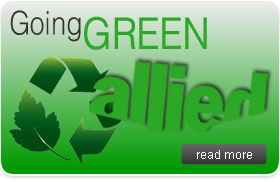Envelope Printing
Allied Printing Resources offers envelopes that can be printed by several different processes. Several factors should be considered when deciding what type of printing process would best satisfy your requirements. You should consider the quality required, the quantity and the type of image being printed. Shown below are brief explanations of different printing processes that are used to print envelopes. The explanations may help you determine the best process for printing your envelopes.
Jet Offset (Lithography) offers the highest quality and most cost efficient way of printing envelopes. It produces a clear, well-defined image area and provides excellent ink coverage. It is effective on many different paper surfaces from smooth vellums through laids, embossed finishes and heavily textured felts. Jet Offset printing is generally done after the envelope is folded, and uses the same printing processes as in lithography. You can print from 1 – 4 colors on front on the envelope and up to 2 colors on the back. (picture of envelope press)
Rules for Offset Printing:
- Allow 1/8" minimum bleeds due to +/- 1/16" variance on envelope converting equipment.
- Keep weight of rules to a minimum of 1/2 pt. Keep to 1 pt. in reverse areas.
- Type can be any point size but a minimum of 5 pt. is recommended, with a 7 pt. minimum in the reverse areas.
- Screens should be 133 to 150 lpi, depending on the press equipment.
- Standard traps are 1/4 pt.
Flexography is a printing process in which the printing plate places ink directly on the paper. Printing is done from plates on which the image to be printed is raised above the non-printing surface. Ink is applied to the raised surface while the surrounding areas are lower and do not receive ink. The inked image is then pressed directly onto the paper.
High-Speed Flexography equipment uses flexographic inks that are water based for fast drying and environmentally friendly. When we print in-line on our envelope folding machines, there is very little time for the ink to dry before the envelope is folded. The use of these inks also provides excellent coverage of solid image areas and will not appear as glossy as traditional flexo inks.
Rules for Flexography and Letterpress printing:
- Allow 1/8" minimum bleeds due to +/- 1/16" variance on envelope converting equipment.
- Keep weight of rules to a minimum of 1 pt. Keep to 1 1/2 pt. in reverse areas.
- Use a minimum of 6 pt. sans serif type for best quality. When using serif type, use a minimum of 8 pt.
- Screens are usually 65 lpi. Keep screen densities at 40% or less for best results.
- Halftones print alright if the original or the digital scan is good quality. Avoid duotones, tritones and gradient screens.
- Avoid having large solids and screens in the same color - use a lighter color of ink instead of screening in the same color.
- Standard traps are 1 pt.
Flat Sheet Litho & Converting is a printing process that uses a flat plate where water is applied to the plate surface and is absorbed into the non-image areas. Then when the ink is applied to the plate, the image areas accept the ink but the non-image areas repel it since ink and water don't mix. The ink is then transferred from the plate to a blanket which in turn transfers the image to the printing surface. Lithography is a high quality printing process used on envelopes after they have been converted into envelope blanks or into a finished envelope. Lithographic printing is generally more expensive on long runs than flexography because it is a separate procedure in the manufacturing process. Even though it is more expensive, it is sometimes preferred because it produces better quality than flexography.
Allied has complete flat sheet printing capabilities.We are able to create packages including design, layout and typesetting to acheive the look and results you need. Our presses stand ready to print your complete direct mail package. Allied is not just an envelope company.
Our capabilities include:
|
|


